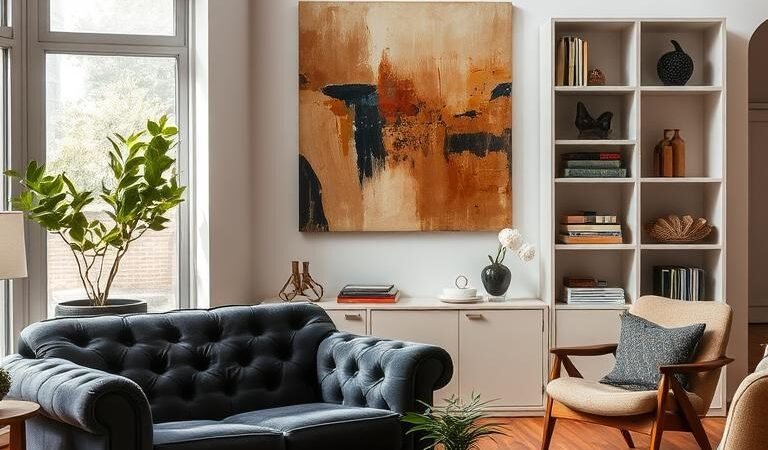Creating a home that reflects your personality doesn’t require a huge budget or professional help. With thoughtful planning, every space can become a unique expression of your style. Whether you love bold colors or minimalist designs, the key lies in blending functionality with personal touches.
Start by considering how you use each area. A cozy reading nook needs soft lighting and textured throws, while a lively dining space benefits from vibrant accents. Designers like Fletcher Rhodes prove that even small changes—like rearranging furniture or adding statement art—can transform a room.
Budget-friendly strategies, such as thrifting or DIY projects, make the process accessible. The goal? A home that feels inviting and tells your story. By focusing on layout, mood boards, and smart spending, you’ll avoid decision paralysis and craft a space you love.
Key Takeaways
- Personalized design combines functionality with individual style.
- Small changes, like furniture placement, can make a big impact.
- Budget-friendly options include thrifting and DIY projects.
- Mood boards help visualize your ideal space.
- Thoughtful layouts enhance both comfort and aesthetics.
1. Introduction to Room-Specific Decorating
Great design isn’t about perfection—it’s about creating spaces that resonate with you. Studies show personalized rooms reduce stress and boost creativity. A sunlit reading nook or a vibrant kitchen can become sanctuaries that reflect your journey.
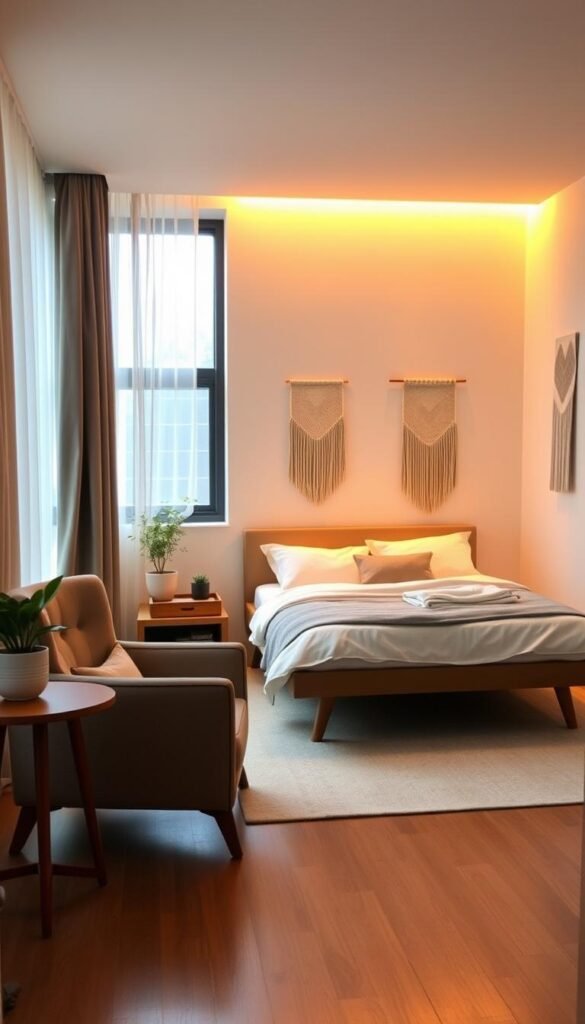
Forget the myth that you need a professional. Designer Fletcher Rhodes transformed a Sonoma living room using thrifted art and strategic lighting—proof that vision matters more than credentials. *The result? A space that whispers comfort and tells a story.*
Your style evolves, just like Pinterest boards. Start with core principles: functionality (durable fabrics for pets), layers (rugs under tables), and cohesion (matching metals). Real homeowners often struggle with clutter or tight budgets—solve this by repurposing furniture or shopping secondhand.
Think of design as a conversation. Walls “speak” through paint; shelves “listen” with curated objects. The payoff? A home that feels unmistakably yours—one thoughtful layer at a time.
2. Set a Realistic Budget for Your Project
Smart budgeting transforms design dreams into reality—without financial stress. Whether refreshing a bedroom or tackling a kitchen remodel, a clear plan keeps costs in check. Start by listing essentials, then allocate funds for surprises. Remember, even small projects benefit from financial foresight.

Prioritize Must-Haves vs. Nice-to-Haves
Separate needs from wants to stretch your budget further. A sofa for family movie nights might trump decorative pillows. For kitchens, durable countertops often outweigh luxury finishes. Pro tip: Use a spreadsheet to rank items by priority and cost.
Consider child- or pet-proofing early. Stain-resistant fabrics or washable paint add long-term value. Real-world example: A $200 reupholstery job saved one homeowner $1,200 on a new couch.
Include a Contingency Fund
Experts recommend reserving 10–20% for unexpected costs. Hidden electrical updates or structural issues can derail plans. One homeowner discovered faulty wiring only after removing wallpaper—$500 became $2,000.
Apply the three-bid rule for contractors. Compare quotes, but also assess reviews and timelines. Digital tools like Mint or Notion simplify tracking, while analog fans swear by bullet journals.
- Budget breakdown: 50% essentials, 30% upgrades, 20% contingency.
- Hidden costs: Permits, disposal fees, or temporary storage.
- Crisis-proofing: Scotchgard for couches, washable rugs for spills.
3. Create a Mood Board for Inspiration
A mood board bridges imagination and reality—transforming scattered ideas into a cohesive vision. Whether digital or tactile, it’s your design compass. Start by collecting textures, color swatches, and furniture pieces that spark joy.
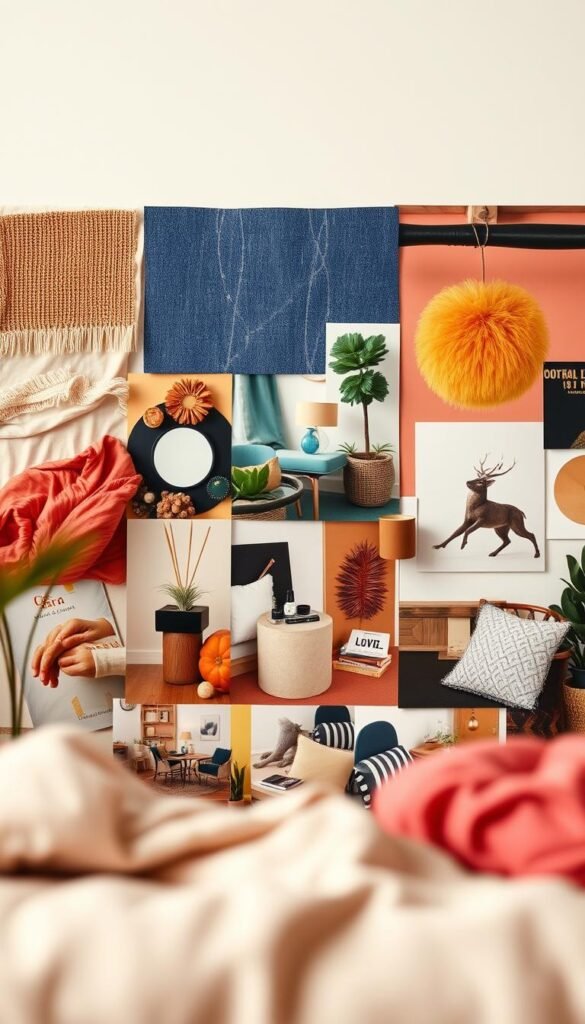
Using Pinterest to Pin Ideas
Pinterest thrives as a virtual scrapbook. Research shows saving 50+ pins reveals consistent style preferences. Isolate furniture from staged scenes using cropping tools. Designer Margo Hupert layered ceramic textures and terracotta tones for her studio—later mirrored in her final space.
Pro workflow:
- Create secret boards for each room.
- Label pins by category (e.g., “lighting,” “wall art”).
- Overlay paint samples on pinned walls using Canva.
Identifying Common Themes
Psychology proves recurring visuals hint at subconscious tastes. Notice three navy-blue accents? Your color palette is speaking. Physical boards excel for tactile learners—clip fabric swatches or tile samples.
Pro tip: Compare old and new boards to track style evolution. A 2022 study found 78% of DIYers refined their aesthetic through this method.
4. Choose Your Springboard Inspiration
Every great design begins with a spark—an object, color, or texture that ignites creativity. Whether it’s a hand-me-down quilt or a modern sculpture, your inspiration piece becomes the heartbeat of the room. *Think of it as a visual anchor that guides every other choice.*
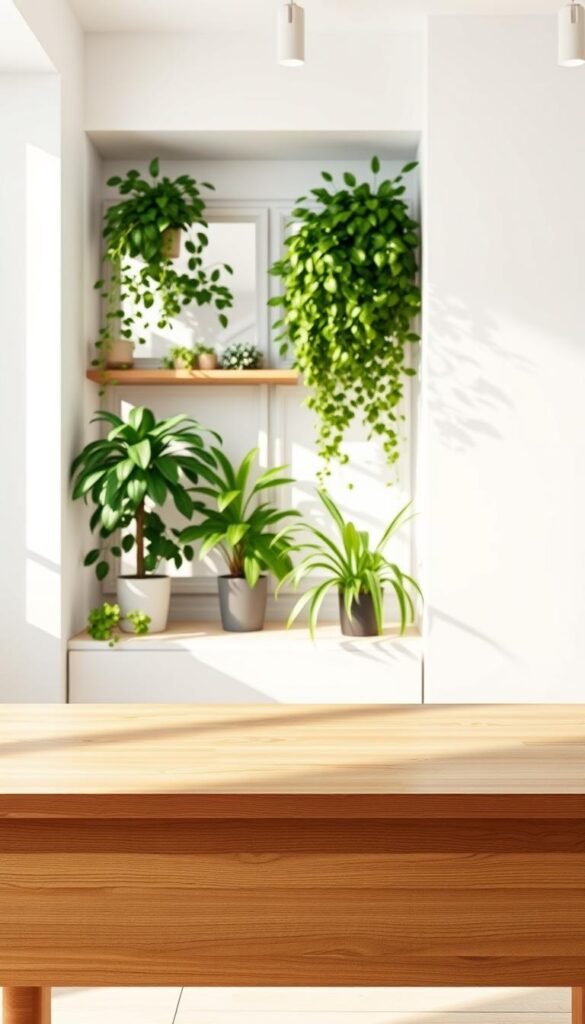
Historical treasures like heirloom rugs whisper stories, while bold contemporary art shouts personality. The deVOL Kitchen team famously built an entire space around a quirky painting—proof that one piece can shape walls, fabrics, and even lighting.
Extract colors from patterned objects effortlessly. A rug’s cobalt stripes might inspire throw pillows, or a vase’s glaze could dictate wall tones. Digital tools like color picker apps simplify this process—just snap a photo and let tech do the rest.
For budget-friendly inspiration, thrift stores are goldmines. A chipped frame or retro lamp often holds more character than mass-produced decor. Social media posts also offer fresh ideas—filter hashtags like #ThriftedFinds or #DIYDecor.
Multi-sensory layers deepen the experience. Pair a jazz playlist with velvet drapes, or match citrus-scented candles to sunny accent walls. As Greenhouse Studio’s guide notes, a springboard object bridges logic and emotion, turning chaos into cohesion.
5. Plan Your Room Layout
A well-planned layout turns chaotic spaces into functional sanctuaries. Whether arranging a cozy living room or a sleek home office, the right plan ensures every inch works for you. Start by measuring—then let creativity shape the way you live.
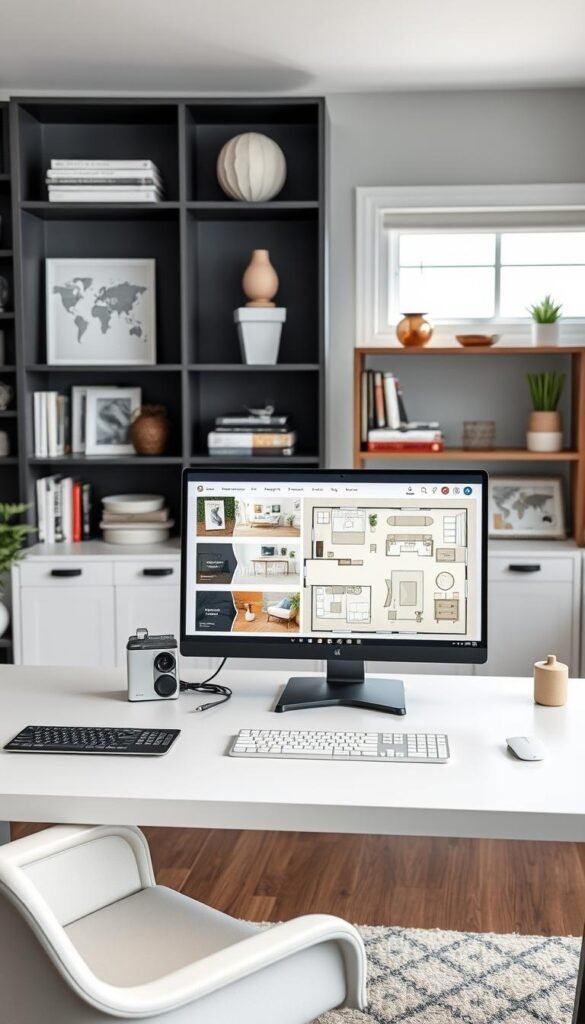
Measure Your Space Accurately
Precision is key. Use painter’s tape to mark furniture footprints on the floor. This reveals walkways and avoids awkward gaps. *Pro tip:* Note ceiling heights—a tall bookshelf might overwhelm a low wall.
For tricky corners, try these professional techniques:
- Record measurements in inches and centimeters for online tools.
- Map outlets and vents to avoid blocking airflow.
- Test weight limits for floors (e.g., pianos or aquariums).
Use Online Tools for Visualization
Digital planners like Roomstyler or AutoCAD bring layouts to life. Upload room dimensions, then drag-and-drop virtual furniture. See how a 12’ leather sofa fits before buying. These tools also calculate ergonomic spacing—ideal for dining chairs or bedside tables.
| Tool | Best For | Learning Curve |
|---|---|---|
| Roomstyler | Beginners; real product imports | Low (drag-and-drop) |
| AutoCAD | Precise blueprints; contractors | High (professional skills) |
Maximize vertical space with floating shelves or loft beds. For tech-heavy rooms, plan outlet zones near desks. Temporary mockups help too—cut cardboard to mimic armchairs or tables. The goal? A space that flows as beautifully as it looks.
6. Select Foundation Furniture Pieces
The right furniture anchors your space—both visually and functionally—while reflecting your lifestyle. Whether you prefer muted neutrals or bold statements, these pieces become the framework for layering textures and colors. Start by assessing daily needs: A family-friendly sectional demands durability, while a vintage armchair might prioritize character.
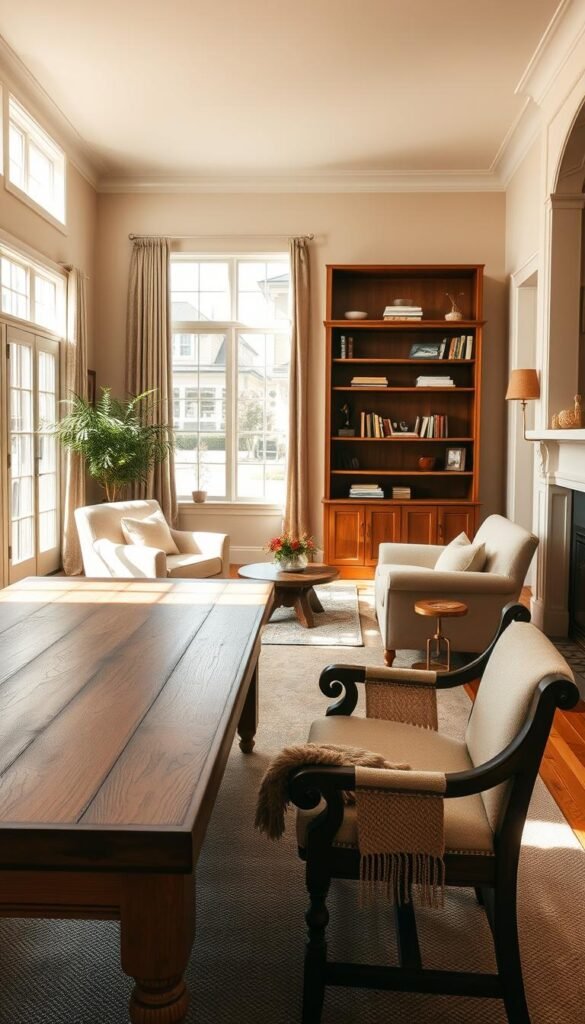
Neutral vs. Statement Furniture
Neutral items—like beige sofas or oak tables—act as chameleons. They adapt to seasonal decor shifts or mixing furniture styles. For contrast, a statement piece (think emerald velvet sofa or hand-carved console) anchors the room’s personality. *Pro tip:* Pair bold furniture with subdued walls to avoid visual chaos.
Durability for Family and Pets
Crypton fabric repels stains like a forcefield—ideal for homes with kids or pets. Compare materials using this guide:
| Material | Best For | Care Level |
|---|---|---|
| Aniline Leather | Luxury feel; ages beautifully | High (avoid direct sun) |
| Top-Grain Leather | Scratch-resistant; family-proof | Medium (wipe spills quickly) |
| Sunbrella Fabric | Outdoor/indoor; fade-proof | Low (machine-washable) |
Modular pieces like Thomasville sectionals offer rearrangeable seats—perfect for growing family needs. For pet owners, tight-weave fabrics resist claws, while rounded edges minimize toddler bumps. *Bonus:* Scotchgard treatments add invisible armor to upholstery.
- Childproofing: Crypton outperforms cotton in stain tests by 73%.
- Longevity: Invest in solid wood frames; avoid particleboard for heavy-use items.
- Delivery: Measure doorways first—some modular furniture ships disassembled.
7. Pick a Paint Palette That Sets the Mood
The right paint palette does more than cover walls—it shapes moods and memories. From energizing yellows to calming blues, colors influence circadian rhythms and spatial perception. Start by testing swatches in your home’s unique light—what looks buttery at noon may turn slate-gray by dusk.
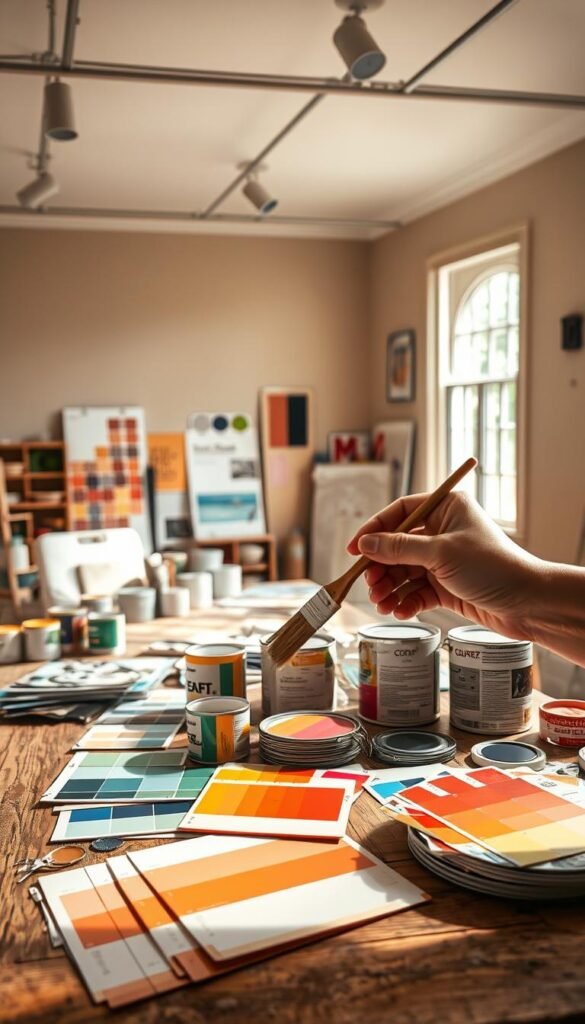
Testing Colors in Your Lighting
Natural and artificial light dramatically alter paint tones. North-facing rooms amplify cool undertones, while evening lamps warm terracotta to ochre. *A misstep here can cost hours—and gallons—of correction.*
Pro techniques for accuracy:
- Circadian rhythm sync: Blues in bedrooms promote sleep; citrus hues energize kitchens.
- Light simulation: Use apps like Sherwin-Williams’ ColorSnap to preview shades at dawn, noon, and dusk.
- Sheen science: Eggshell reflects light softly—matte hides flaws but stains easily.
Coordinating with Fabrics and Textures
Pull colors from existing textiles for cohesion. A rug’s saffron threads might inspire an accent wall, while linen curtains could dictate trim tones. Designer Nyla James famously matched a client’s velvet sofa to Farrow & Ball’s “Dead Salmon”—a pink-gray that whispered sophistication.
| Material | Color Extraction Tip | Paint Pairing |
|---|---|---|
| Wool Rugs | Isolate the least dominant hue | Benjamin Moore’s “Pale Oak” (warm gray) |
| Silk Pillows | Photograph in indirect light | Sherwin-Williams’ “Alabaster” (soft white) |
For eco-friendly options, look for low-VOC paint like Clare’s “Current Mood” line. Historical trends also inspire—Victorian greens or mid-century mint offer timeless depth. Remember: Your palette should feel like home, not a trend report.
8. Layer in Textiles and Accessories
Textiles and accessories transform rooms from functional to unforgettable. Like a signature scent or favorite playlist, these layers add depth and personality. The right mix creates comfort while telling your unique story.
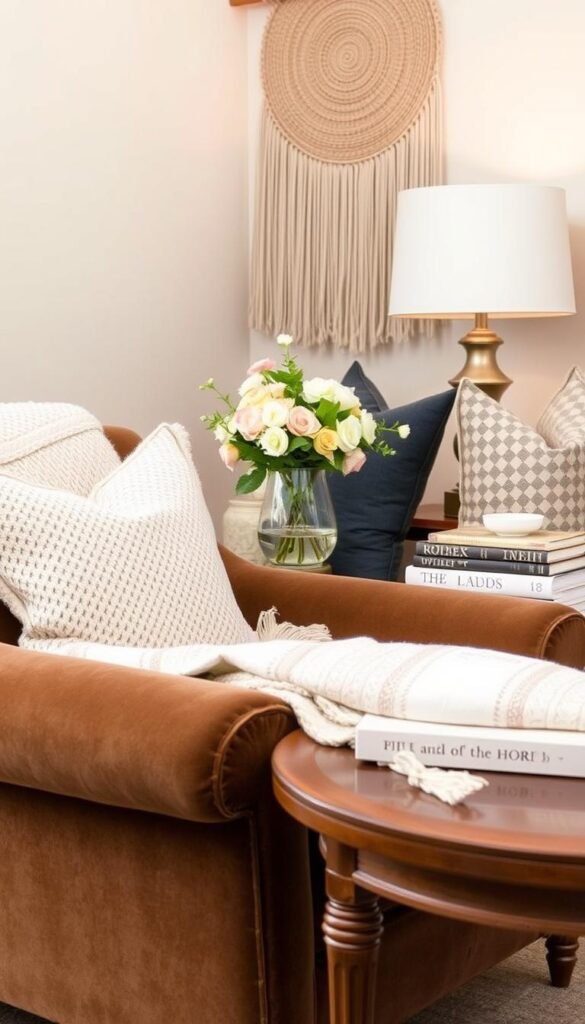
Mixing Patterns and Textures
Start with a neutral base—like a beige sofa or jute rug—then build contrast. Pair chunky wool throws with smooth leather pieces for tactile intrigue. *Pro tip:* Limit bold patterns to 30% of the space to avoid visual overload.
Follow these professional guidelines for harmony:
- Scale variation: Combine large floral prints with small geometric patterns
- Color threads: Use one repeating hue across different textiles
- Seasonal swaps: Rotate linen cushions for summer, faux fur for winter
Material mixing matters too. A budget-friendly living room might layer:
| Texture | Purpose | Budget Tip |
|---|---|---|
| Wool throw | Winter warmth | Thrift vintage Pendleton blankets |
| Linen napkins | Summer lightness | Buy remnants from fabric stores |
Incorporating Personal Mementos
Sentimental items—like grandmother’s quilt or travel souvenirs—make spaces truly yours. Display them at eye level for maximum impact. Odd-numbered groupings (3 or 5 objects) create natural focal points.
Preserve delicate heirlooms with these smart strategies:
- Shadow boxes: Protect fragile items behind UV-resistant glass
- Functional displays: Use vintage trays as coffee table organizers
- Childproofing: Secure wicker lids with leather straps
Multi-functional accessories add charm without clutter. An ottoman stores blankets while serving as extra seating. Repurposed ladders become rustic bookshelves. Remember—every layer should spark joy and serve a purpose.
9. Add Lighting for Ambiance and Function
Lighting transforms rooms from ordinary to extraordinary—it’s the unsung hero of design. The right mix of brightness and shadow can make a space feel cozy or energizing. Start by mapping three layers: overhead, task, and accent light.
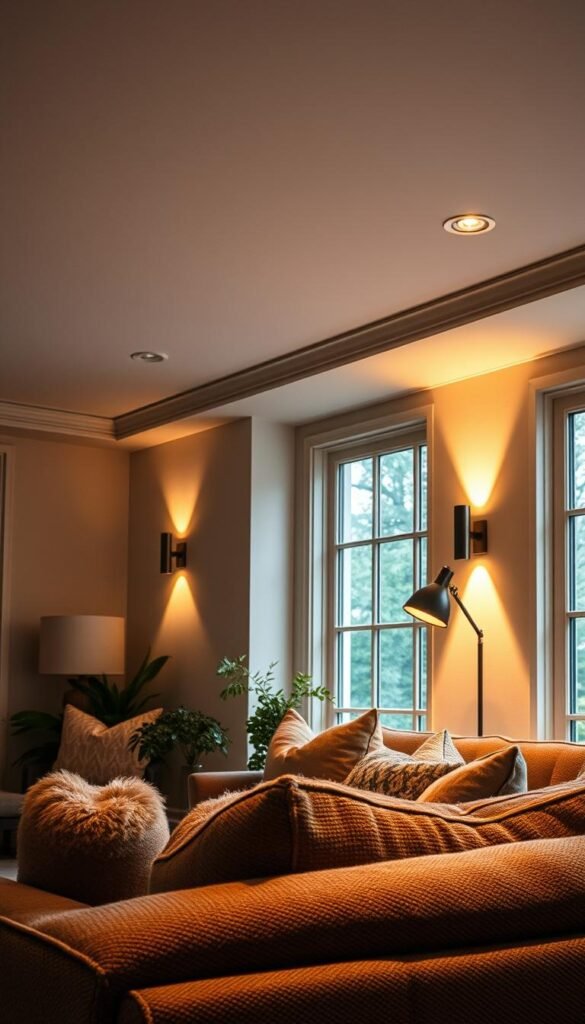
Overhead vs. Task Lighting
Overhead fixtures like chandeliers or recessed lights blanket the entire room in brightness. They’re ideal for social areas but can feel harsh alone. *Pro tip:* Pair them with dimmers to control mood.
Task lighting focuses on work zones. Think under-cabinet strips for chopping veggies or adjustable desk lamps. A study by the Lighting Research Center found proper task light reduces eye strain by 51%.
Choosing the Right Fixtures
Match fixtures to your design style and needs. A vintage brass pendant adds character, while flush mounts save headroom in low ceilings. For homes with ceiling fans, look for integrated light kits—they’re a stylish compromise.
| Fixture Type | Best For | Smart Features |
|---|---|---|
| Pendant Lights | Dining tables, islands | Voice-controlled dimming |
| Track Lighting | Gallery walls, kitchens | Adjustable beam angles |
Quick safety checklist for DIY installs:
- Vintage rewiring: Always hire an electrician for pre-1970s fixtures
- Light temperature: 2700K-3000K for warmth; 4000K+ for offices
- Outdoor prep: Use wet-rated fixtures in rainy climates
10. Conclusion: Enjoy Your Personalized Space
Your home becomes a living story—each choice adding depth to its narrative. Step back and admire the layers: the heirloom quilt draped just so, the paint shade that shifts with the light. This is your signature style, perfected over time.
Keep the magic alive with simple rituals. Revisit your space seasonally—rotate art, swap textiles, or add a vintage find. Track design evolution with photos; they’ll reveal how your tastes refine. *Pro tip:* Host a debut gathering to see the room through fresh eyes.
Future-proof your choices. Use washable fabrics in high-traffic zones, or label paint cans for touch-ups. Most importantly, find joy in the way your home grows with you. After all, the best spaces aren’t finished—they’re forever becoming.
